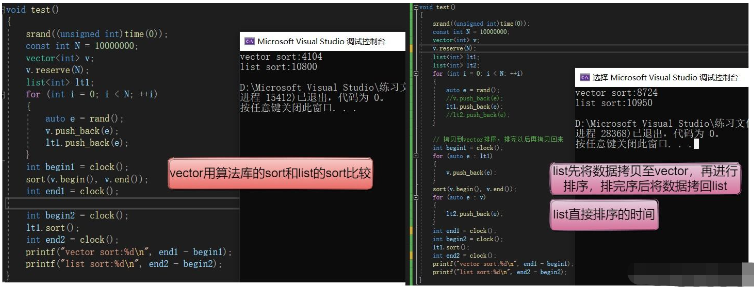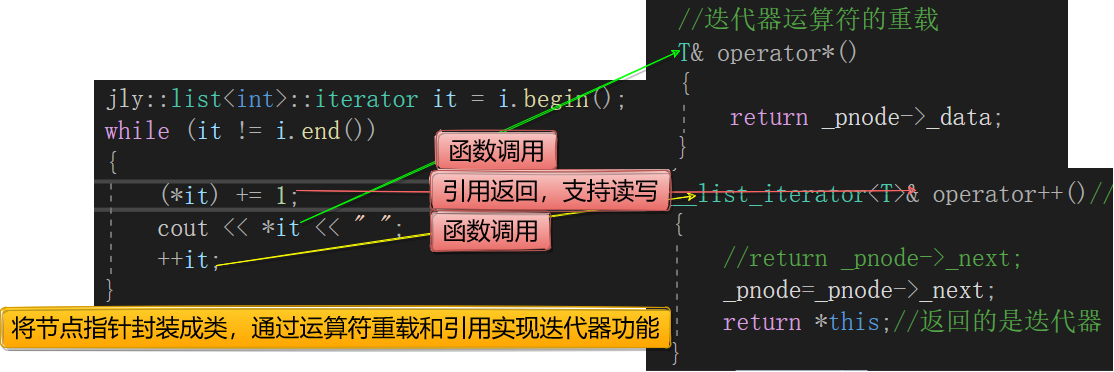您好,登錄后才能下訂單哦!
您好,登錄后才能下訂單哦!
這篇文章主要介紹了怎么用C++模擬實現STL容器的相關知識,內容詳細易懂,操作簡單快捷,具有一定借鑒價值,相信大家閱讀完這篇怎么用C++模擬實現STL容器文章都會有所收獲,下面我們一起來看看吧。
列表是一種順序容器,它允許在序列中的任何位置執行常量時間插入和刪除操作,并允許在兩個方向上進行迭代。它的底層是一個帶頭雙向循環鏈表。
list不能用算法庫的sort進行排序。算法庫中的sort的底層是一個快排,需滿足三數取中,需要傳入隨機訪問迭代器,所以list并不適用。
當然list中提供了一個自己的sort,它的底層是一個歸并排序。但是這個sort比vector使用算法庫的sort還慢,甚至比list的數據先push_back到vector到再用算法庫的sort還要慢。

insert,迭代器不失效
earse失效
1、單向迭代器:只能++,不能--。例如單鏈表,哈希表;
2、雙向迭代器:既能++也能--。例如雙向鏈表;
3、隨機訪問迭代器:能++--,也能+和-。例如vector和string。
迭代器是內嵌類型(內部類或定義在類里)
普通迭代器
迭代器的實現需要支持解引用(為了取數據),支持++--。
博主模擬實現string和vector時,直接將原生指針typedef成迭代器,是因為數組的結構正好滿足迭代器的行為(注:string和vector可以用原生指針實現,但是vs中采用自定義類型封裝的方式實現),但是list中的節點地址是不連續的,不能使用原生指針,需要使用類進行封裝+運算符重載實現。
//用類封裝迭代器
template <class T>
struct __list_iterator
{
typedef list_node<T> node;
//用節點的指針進行構造
__list_iterator(node* p)
:_pnode(p)
{}
//迭代器運算符的重載
T& operator*()
{
return _pnode->_data;
}
__list_iterator<T>& operator++()//返回值不要寫成node* operator++(),因為迭代器++肯定返回迭代器啊,你返回節點指針類型不對
{
//return _pnode->_next;
_pnode=_pnode->_next;
return *this;//返回的是迭代器
}
bool operator!=(const __list_iterator<T>& it)
{
return _pnode != it._pnode;
}
public:
node* _pnode;//封裝一個節點的指針
};
const迭代器
const迭代器的錯誤寫法:
typedef __list_iterator<T> iterator; const list<T>::iterator it=lt.begin();
因為typedef后,const修飾的是迭代器it,只能調用operator*(),調不了operator++()。(重載operator++()為const operator++()也不行,因為const版本++還是改變不了)
正確寫法:想實現const迭代器,不能在同一個類里面動腦筋,需要再寫一個const版本迭代器的類。
//用類封裝const迭代器
template <class T>
struct __list_const_iterator
{
typedef list_node<T> node;
//用節點的指針進行構造
__list_const_iterator(node* p)
:_pnode(p)
{}
//迭代器運算符的重載
const T& operator*()const
{
return _pnode->_data;
}
__list_const_iterator<T>& operator++()//返回值不要寫成node*,因為迭代器++肯定返回迭代器啊,你返回節點指針類型不對
{
//return _pnode->_next;//返回類型錯誤的
_pnode = _pnode->_next;
return *this;//返回的是迭代器
}
__list_const_iterator<T>& operator--()
{
_pnode = _pnode->_prev;
return *this;
}
bool operator!=(const __list_const_iterator<T>& it)const
{
return _pnode != it._pnode;
}
public:
node* _pnode;//封裝一個節點的指針
};
typedef __list_const_iterator<T> const_iterator;當然,這樣寫__list_iterator和__list_const_iterator這兩個類會出現代碼重復。STL庫中是通過類模板多給一個參數來實現,這樣,同一份類模板就可以生成兩種不同的類型的迭代器(以下為仿STL庫的模擬實現):
//用類封裝普通/const迭代器
template <class T,class Ref>
struct __list_iterator
{
typedef list_node<T> node;
typedef __list_iterator<T,Ref> Self;
//用節點的指針進行構造
__list_iterator(node* p)
:_pnode(p)
{}
//迭代器運算符的重載
Ref operator*()
{
return _pnode->_data;
}
Self& operator++()//返回值不要寫成node*,因為迭代器++肯定返回迭代器啊,你返回節點指針類型不對
{
//return _pnode->_next;//返回類型錯誤的
_pnode=_pnode->_next;
return *this;//返回的是迭代器
}
Self& operator--()
{
_pnode = _pnode->_prev;
return *this;
}
bool operator!=(const Self& it)
{
return _pnode != it._pnode;
}
public:
node* _pnode;//封裝一個節點的指針
};
typedef __list_iterator<T, T&> iterator;
typedef __list_iterator<T, const T&> const_iterator;1、封裝底層實現,不暴露底層實現的細節;
2、多種容器提供統一的訪問方式,降低使用成本;
C語言沒有運算符重載和引用等語法,是實現不了迭代器的。
迭代器的用法就是模擬指針的行為,如果現在有一個指向結構的指針,那么就需要用到->來解引用。
//*的重載:返回節點的數據
Ref operator*()
{
return _pnode->_data;
}
//->的重載:返回數據的指針
T* operator->()
{
return &_pnode->_data;
}
但是operator->使用T*做返回值類型,這樣無論是普通迭代器和const迭代器都能修改,所以operator->的返回值類型應該改為泛型:
template <class T, class Ref,class Ptr>
Ptr operator->()
{
return &_pnode->_data;
}
typedef __list_iterator<T, T&, T*> iterator;
typedef __list_iterator<T, const T&, const T*> const_iterator;1、調用拷貝構造時,鏈表內節點數據為什么已經是深拷貝了?

2、類名和類型的區別
普通類:類名等于類型
類模板:類名不等價于類型,例如list類模板類名是list,類型list<int>等。
所以我們平常寫函數形參和返回值時,總會帶上形參和返回值的類型:
// 賦值運算符重載寫法2(賦值運算符重載都可以這么干)
list<T>& operator=(list<T> lt)
{
swap(lt);
return *this;
}但是C++在類模板里面可以用類名代替類型:
// 賦值運算符重載寫法2(賦值運算符重載都可以這么干)
list& operator=(list lt)
{
swap(lt);
return *this;
}建議寫代碼的時候嚴格區分類型和類名,讓自己和別人能夠看的很明白。(了解下C++有這種坑語法即可)
vector和list像左右手一樣,是互補關系,缺一不可。vector的優點正是list的缺點,list的優點也是vector的缺點,實際選用容器時,按照需求擇優選用。
vector的優點(結構厲害):
1、支持下標的隨機訪問;
2、尾插尾刪效率高(當然擴容的那一次尾插尾刪會較慢);
3、CPU高速緩存命中高(數據從緩存加載至CPU中,會加載連續的一段數據,vector因為結構連續,高速緩存命中高)。
vector的缺點:
1、非尾插尾刪效率低;
2、擴容有消耗,并存在一定的空間浪費。
vector迭代器失效問題:
insert/erase均失效。(如果string的insert和erase形參是迭代器,那么也會失效,但是大部分接口是下標傳參,不考慮失效問題,只有幾個接口是迭代器傳參,需要注意迭代器失效問題)
list的優點:
1、按需申請釋放,無需擴容;
2、任意位置插入刪除時間O(1);(這里說的是插入刪除,不要加上查找的時間)
list的缺點:
1、不支持下標的隨機訪問;
2、CPU高速緩存命中率低;
3、每一個節點除了存儲數據外,還需要額外存儲兩個指針。
list迭代器失效問題:
insert不失效,erase失效。
#pragma once
#include <iostream>
#include <algorithm>
#include <assert.h>
#include <vector>
using std::cout;
using std::endl;
namespace jly
{
//鏈表節點的類
template <class T>
struct list_node
{
list_node(const T& x = T())//給一個缺省值,變成默認構造函數
:_next(nullptr)
, _prev(nullptr)
, _data(x)
{}
list_node* _next;
list_node* _prev;
T _data;
};
//用類封裝普通/const迭代器
template <class T, class Ref,class Ptr>
struct __list_iterator
{
typedef list_node<T> node;
typedef __list_iterator<T, Ref,Ptr> Self;
//用節點的指針進行構造
__list_iterator(node* p)
:_pnode(p)
{}
//迭代器運算符的重載
Ref operator*()
{
return _pnode->_data;
}
Ptr operator->()
{
return &_pnode->_data;
}
Self& operator++()//返回值不要寫成node*,因為迭代器++肯定返回迭代器啊,你返回節點指針類型不對
{
//return _pnode->_next;//返回類型錯誤的
_pnode = _pnode->_next;
return *this;//返回的是迭代器
}
Self operator++(int)//后置++
{
_pnode = _pnode->_next;
return Self(_pnode->_next);
}
Self& operator--()
{
_pnode = _pnode->_prev;
return *this;
}
Self operator--(int)//后置--
{
_pnode = _pnode->_prev;
return Self(_pnode->_prev);
}
bool operator!=(const Self& it)const
{
return _pnode != it._pnode;
}
bool operator==(const Self& it)const
{
return _pnode == it._pnode;
}
public:
node* _pnode;//封裝一個節點的指針
};
//用類封裝const迭代器
//template <class T>
//struct __list_const_iterator
//{
// typedef list_node<T> node;
// //用節點的指針進行構造
// __list_const_iterator(node* p)
// :_pnode(p)
// {}
// //迭代器運算符的重載
// const T& operator*()const
// {
// return _pnode->_data;
// }
// __list_const_iterator<T>& operator++()//返回值不要寫成node*,因為迭代器++肯定返回迭代器啊,你返回節點指針類型不對
// {
// //return _pnode->_next;//返回類型錯誤的
// _pnode = _pnode->_next;
// return *this;//返回的是迭代器
// }
// __list_const_iterator<T>& operator--()
// {
// _pnode = _pnode->_prev;
// return *this;
// }
// bool operator!=(const __list_const_iterator<T>& it)const
// {
// return _pnode != it._pnode;
// }
//public:
// node* _pnode;//封裝一個節點的指針
//};
//鏈表類(控制哨兵位)
template <class T>
class list
{
public:
typedef list_node<T> node;
typedef __list_iterator<T, T&,T*> iterator;
typedef __list_iterator<T, const T&,const T*> const_iterator;
//typedef __list_const_iterator<T> const_iterator;
//構造函數
void empty_initialize()//用于初始化哨兵位
{
_head = new node;
_head->_next = _head;
_head->_prev = _head;
_size = 0;
}
list()
{
empty_initialize();
}
template <class InputIterator>
list(InputIterator first, InputIterator last)//迭代器區間構造
{
empty_initialize();
while (first != last)
{
push_back(*first);
++first;
}
}
//析構函數
~list()
{
clear();
delete _head;
_head = nullptr;
}
//拷貝構造
list(const list<T>& lt)
{
先初始化*this
//empty_initialize();
//for (const auto& e : lt)//取lt的數據給e
//{
// push_back(e);
//}
//工具人寫法
list<T> tmp(lt.begin(),lt.end());
empty_initialize();
swap(tmp);
}
void swap(list<T>& lt)
{
std::swap(_head, lt._head);//交換頭指針
std::swap(_size,lt._size);
}
賦值運算符重載寫法1
//list<T>& operator=(const list<T>& lt)
//{
// //防止自己給自己賦值
// if (this != <)
// {
// clear();
// for (const auto& e : lt)
// {
// push_back(e);
// }
// }
// return *this;
//}
// 賦值運算符重載寫法2(賦值運算符重載都可以這么干)
list<T>& operator=(list<T> lt)
{
swap(lt);//直接交換
return *this;
}
//插入刪除
void push_back(const T& x)
{
/*node* newNode = new node(x);
node* tail = _head->_prev;
newNode->_prev = tail;
newNode->_next = _head;
tail->_next = newNode;
_head->_prev = newNode;*/
insert(end(), x);
}
void pop_back()
{
erase(--end());
}
void push_front(const T& x)//頭插
{
insert(begin(), x);
}
void pop_front()
{
erase(begin());
}
iterator insert(iterator pos, const T& x)
{
node* newNode = new node(x);
node* prev = pos._pnode->_prev;
node* cur = pos._pnode;
newNode->_prev = prev;
newNode->_next = cur;
prev->_next = newNode;
cur->_prev = newNode;
//return iterator(newNode);
pos._pnode = newNode;
++_size;
return pos;
}
iterator erase(iterator pos)
{
assert(!empty());
node* prev = pos._pnode->_prev;
node* next = pos._pnode->_next;
prev->_next = next;
next->_prev = prev;
delete pos._pnode;
--_size;
//return iterator(next);
pos._pnode = next;
return pos;
}
//鏈表小接口
bool empty()const
{
return _head->_next == _head;
}
void clear()
{
/*assert(!empty);
node* cur = _head->_next;
while (cur != _head)
{
node* next = cur->_next;
delete cur;
cur = next;
}*/
iterator it = begin();
while (it != end())
{
it = erase(it);//erase返回刪除元素的下一個
}
}
size_t size()const
{
return _size;
}
//普通begin(),end()迭代器
iterator begin()
{
//return iterator(_head->_next);
return __list_iterator<T, T&,T*>(_head->_next);
}
iterator end()
{
return __list_iterator<T, T&,T*>(_head);
}
//const begin(),end()迭代器
const_iterator begin()const
{
//return const_iterator(_head->_next);
return __list_iterator<T, const T&,const T*>(_head->_next);
}
const_iterator end()const
{
return __list_iterator<T, const T&,const T*>(_head);
}
private:
node* _head;//哨兵位
size_t _size;//用于統計節點個數,空間換時間
//不加這個私有變量,統計節點個數時間O(N),有這個私有變量,時間O(1),但是每個節點的體積變大
};
//測試函數
struct Pos
{
int _row;
int _col;
Pos(int row = 0, int col = 0)
:_row(row)
, _col(col)
{}
};
void test()
{
list<Pos> i;
i.push_back(Pos(1, 2));
i.push_back(Pos(2, 5));
i.push_back(Pos(4, 3));
list<Pos>::iterator it = i.begin();
while (it != i.end())
{
cout << (&( * it))->_row;//*it取數據,再取地址、解引用得到_row,多此一舉
cout << it->_row;//同第三種寫法,編譯器為了可讀性,省略了一個->
cout << it.operator->()->_row;//it.operator->()是顯示調用,->_row是解引用得到_row
it++;
}
}
void test1()
{
list<std::vector<int>> i;
std::vector<int> v1(1, 2);
std::vector<int> v2(2, 4);
std::vector<int> v3(3, 5);
i.push_back(v1);
i.push_back(v2);
i.push_back(v3);
list<std::vector<int>> m(i);
i = m;
cout << m.size();
}
}關于“怎么用C++模擬實現STL容器”這篇文章的內容就介紹到這里,感謝各位的閱讀!相信大家對“怎么用C++模擬實現STL容器”知識都有一定的了解,大家如果還想學習更多知識,歡迎關注億速云行業資訊頻道。
免責聲明:本站發布的內容(圖片、視頻和文字)以原創、轉載和分享為主,文章觀點不代表本網站立場,如果涉及侵權請聯系站長郵箱:is@yisu.com進行舉報,并提供相關證據,一經查實,將立刻刪除涉嫌侵權內容。